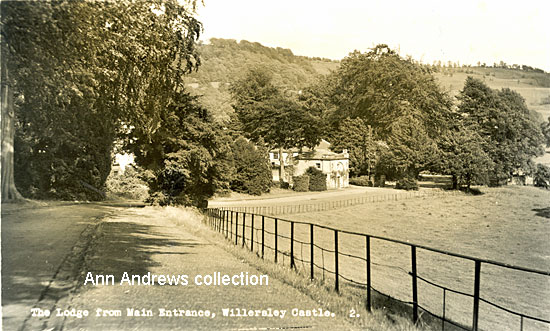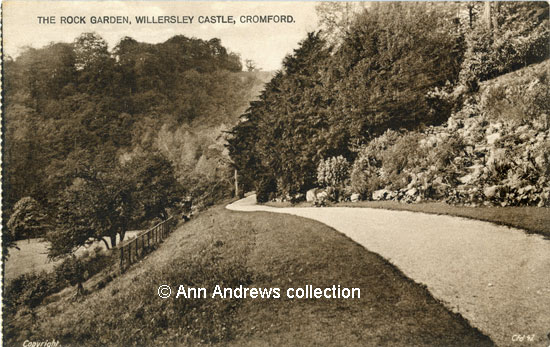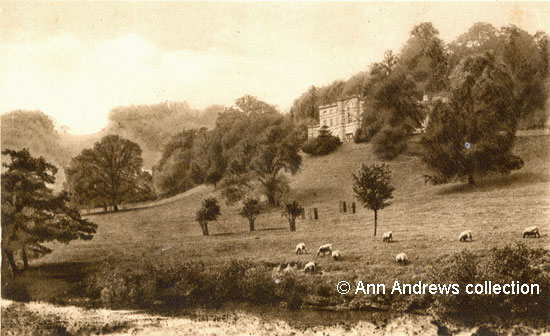|
Images Index> Matlock, 20th and 21stC Images> This page |
| Matlock : Willersley Castle, the Lodge & Gardens of the Arkwrights |
| Matlock : Twentieth Century Photographs, Postcards, Engravings & Etchings |
|
||||
Amongst those employees of the Arkwrights who are known to have lived at the Willersley Lane Lodge between 1841 and 1911 were - as far as possible named in chronological order - Mr and Mrs. William Smith[1] (he was also a gardener), the Gardoms[2], William Froggatt and his wife[3], Thomas Mather[4] and Mr. William Kidd[5].
Although they were not open on a daily basis the castle grounds were one of the tourist attractions of the district and visitors could arrive by canal barge at Cromford Wharf in earlier days, then later by train and charabanc. In 1889, for example, the gardens and grounds were open to the public every Monday, from the first of May till the end of October[7]. The gardens were still opening on Mondays during the season in 1903; tickets could be obtained from the hotels and boarding houses in Matlock Bath, and admission was free. By 1911 visitors had to apply to the Steward for their tickets and this was still the case in 1926, shortly before Willersley was sold[8]. In late November 1902 it was announced that "The gardens at Willersley Castle will be thrown open for public inspection on Saturday and Sunday afternoons, entrance being possible either from Lodge or the Lovers' Walks gates"[9]. This was most likely for an event similar to the one held in 1906. That year, despite poor weather, a constant stream of people visited Willersley over the course of a weekend in November to see the magnificent display of chrysanthemums grown by Mr. Jeal[10]. The Willersley blooms were said to be one of the principal floral displays in the district. Willersley's gardeners competed against their counterparts from the other grand houses in the district at the local flower shows, some of which were held in Willersley's grounds. On the day of the Cromford's Annual Horticultural Show of 1901, an event run by the Cromford & Matlock Bath Society, the Castle grounds and gardens were open to the public for the entire day. Tents (presumably marquees) were put up in the paddock below the mansion and the exhibitors took along what they wished to show. "Beautiful green grass, majestic trees, a swiftly flowing river, rugged rocks - these form the foreground". And, of course, the Masson Mill Brass Band provided the music[11]. The gardens were also used for fund raising bazaars such as the one in 1893 "in aid of the Cromford Voluntary School Building Fund, held in the superb grounds of Willersley Castle"[12].
One of the hampers of plants that the thieves had filled weighed over a hundredweight, and some of the ferns had taken half a century to grow to the size they were. They were planted amongst the rocks in the pleasure grounds as well as by the side of the walks and the principal walks had been totally denuded of plants. It is not known whether any of what had been dug up was able to be re-planted but it was claimed that it would take 40 years to replace them. In addition to the damage to the gardens, the police discovered more problems when they went to the fernery with Mr Jeal, who was the head gardener at the time. They found considerable damage had been done, with ferns pulled up and others trampled. It was said at the trial that the lowest value was £3 but the ferns would have fetched considerably more than that. The culprits were sent to prison for three months with hard labour[13].
Someone who must have worked under George Stafford was Thomas Green, later of the Rock Inn, as he became an under gardener at Willersley in 1830 when he was 18[18]. William Kerr followed on from Mr. Stafford[19] and two of his under gardeners in the 1853-54 period were Thomas Potter[20] and Joseph Rolley[21]. Five more men, Messrs Gadd (the head gardener), Boden, Worthy, Roper and Hodgkinson, were in the gardeners' cottages at the Castle in 1861[22] but by 1866 James Tissington had taken over from Mr. Gadd; he was listed as one of the mourners at the funeral of Peter Arkwright, so must have been important to the family[23]. A few years later he was a judge at the Cromford Flower Show, one of the requisites of the job. He died in 1885 and was buried at St. Mark's, Cromford[24]. He was replaced by William Barlas[25] who, in turn, was followed in 1892 by George Frederick Jeal; it was on his watch that the destruction and theft of the ferns took place (see above). George Jeal went on to win a prize for his exhibits at Matlock Bath Floral fete and we already know how superb his chrysanthemums were (see above). He was at Willersley until at least 1908 before moving on to become self employed[26]. The final head gardener to work for the Arkwright family
was William Read who was at Willersley until at least 1918 when
the Castle was used as the Willersley Auxiliary Hospital[27].
The Gardener's Cottages were still occupied by gardeners just before
the Second World War, one by Charles Thompson and another by Albert
Lynam[28], but the days
of grand houses such as Willersley with a large number of staff
supporting them were over.
|
||||
|
1. "The Lodge from Willersley Castle, Main Entrance". Published by A. W. Bourne, 32 Babingley Drive, Leicester, No.2. Posted on 6 Oct 1959 at Matlock. 2. "The Rock Garden, Willersley Castle, Cromford". No publisher. No.Cfd.42. Copyright. Not used. 3. "A View from the Rock Garden, Willersley Castle". Published by Lilywhite Ltd. Brighouse, No. W.C.9. Copyright. Posted on 2 Aug 1930. Matlock. 4. "Willersley Castle, Cromford, Matlock". Published by Photochrom Co. Ltd., Graphic Studios, Tunbridge Wells, Kent No.33300. Unused. This could date from before WW1. Postcards in the collection of and provided by and © Ann Andrews. Researched, written by and © Ann Andrews. Intended for personal use only. |
||||
References (coloured links are to transcripts or more information elsewhere on this web site): [1] Mr and Mrs. William Smith lived at the Lodge in the 1841 census. He was shown as a gardener in Kelly's 1848 Directory, though not at Willersley. [2] The Gardoms were at the Lodge in the 1851 census. [3] William Froggatt was the Lodge keeper in the 1861 census | the 1871 census. [4] Thomas Mather was sharing the Lodge keeper's house in 1861. [5] The Kidds were living at the Lodge in the 1871 census | in the 1881 census. They were probably still there in the 1891 census, although it doesn't say so, and then living in 4 rooms at Willersley Lodge in the 1901 census. [6] This is from several sources, including Willersley Castle Estate Sale, 1927, "The Times", Wednesday, 7 Nov, 1923 and the "Derbyshire Times", 1 December 1923. The last two references are from when the house was advertised to be let, furnished or unfurnished. [7] "Derbyshire Times", 27 November 1889. Willersley Castle, Gardens and Grounds. [8] Information from Ward Lock Guides published in 1903, 1911-12 and 1926-7. [9] "Derbyshire Times", 26 November 1902. [10] "ibid.", 24 November 1906. [11] "Derbyshire Courier", 30 July 1901. [12] "Derbyshire Times", 12 August 1893. Grand Bazaar at Willersley Castle. [13] "ibid.", 2 September 1905.Willersley Castle Ferns Destroyed. Will Take 40 Years To Replace Them. [14] "Hereford Journal", of 4 July 1832 and 18 July 1832. [15] "Derbyshire Advertiser and Journal", 22 May 1846. "Suddenly at Matlock Bath, on Friday the 15th instant, Mr George Stafford, late gardener to the late R Arkwright, Esq., of Willersley, aged 70 years, highly respected by all who knew him". He was buried at St. Giles'. George Stafford was living at Willersley's Gardener's Cottage in the 1841 census. His widow, Theophilia, was living near the Temple Hotel with her daughter's family at the time of the 1851 census and was still there in 1861. She died, aged 81, in 1868. [16] "Hereford Times", 26 June 1847 [and other papers]. Gooseberry Tree. It is worth mentioning that the "Derby Daily Telegraph" of 2 Feb 1926 reported that the family had no record of the existence of such a large tree and its existence was doubted. [17] Adam, W. (1857, 6th edition) "The Gem of the Peak; or Matlock Bath and Its Vicinity". ... John and Charles Mozley, Derby and 6, Paternoster Row, London; Bemrose .... [18] "Derby Daily Telegraph", 19 June 1909. The information is from a report on the 90th birthday of Mr Thomas Green of the Rock Inn in Matlock. He had been born at Allestree in 1812. There is more about him on Holt Lane and Dale Road, about 1900. [19] William Kerr was shown at the Gardener's House in Bagshaw's Directory 1846 | the 1851 census | White's 1857 Directory. He had retired by 1861 and had moved to Baslow. He eventually moved to Bakewell where he was buried on 23 Mar 1875 [20] "Derbyshire Courier", 14 May 1853. Report of the death of "Mr. Thos. Potter, assistant gardener at Willersley Castle, aged 59 years, much respected". [21] "ibid.", 6 May 1854. [Notice of Death] "Cromford, on the 26th of April, Joseph Rolley, under gardener P. Arkwright, Esq., of Willersley Castle, aged 23 years, much respected". [22] Messrs Gadd, Boden, Worthy, Roper and Hodgkinson were all in the Gardener's accommodation in the 1861 census. Not all were gardeners. Unfortunately, John Worthy was to take his own life in 1870, aged 46, leaving behind a wife and child ("Sheffield Independent", 8 January 1870). He had worked for the Arkwright family for almost 25 years. [23] "The Derby Mercury", 3 October 1866, mourner at the funeral of Peter Arkwright. [24] James Tissington, a local lad who had been christened at St. Mary's in 1834, was living at the Gardener's House in the 1871 census | the 1881 census. James died at Willersley-gardens on 24 Sep 1885. His will was proved by his brother Henry, headmaster of Cromford School. There is more about James Tissington in Strays, Surnames T (scroll down the page). [25] The Barlas family can be found in the 1891 census. He was mentioned as the gardener for F. C. Arkwright in the "Derbyshire Times" of 16 August 1890. By 1901 they had returned to Perthshire and were living at Moulin. [26] Mr. Jeal was (presumably, as it doesn't say so) living in the Gardener's House the 1901 census. He had previously worked at Rawdon Hill Hall in Yorkshire. He was mentioned as working at Willersley in the "Derbyshire Courier" of 20 August 1892 in a report about although they mis spelt his surname. He subsequently moved to Sudbury in Suffolk where he worked for himself as a nurseryman and florist, passing away in 1928. [27] In 1911 William Read was at the Gardener's Cottage. He was the Head Gardener and was still there in 1918 when it was the Willersley Auxiliary Hospital. [28] Information from the 1939 Register, available on FindMyPast. |








